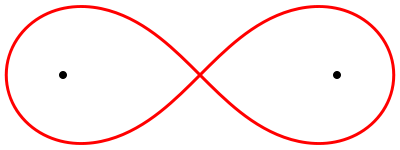Lemniscate

In algebraic geometry, a lemniscate is any of several figure-eight or ∞-shaped curves.[1][2] The word comes from the Latin "lēmniscātus" meaning "decorated with ribbons", from the Greek λημνίσκος meaning ribbons, [2] or alternatively may refer to the wool from which the ribbons were made.[1]
History and examples
Lemniscate of Booth
Although the name "lemniscate" dates to the late 17th century, the consideration of curves with a figure eight shape can be traced back to Proclus, a Greek Neoplatonist philosopher and mathematician who lived in the 5th century AD. Proclus considered the cross-sections of a torus by a plane parallel to the axis of the torus. As he observed, for most such sections the cross section consists of either one or two ovals; however, when the plane is tangent to the inner surface of the torus, the cross-section takes on a figure-eight shape, which Proclus called a horse fetter (a device for holding two feet of a horse together). The Greek phrase for a horse fetter became the word hippopede, the name for this figure-eight shaped curve, which is also called the lemniscate of Booth. It may be defined algebraically as the zero set of the quartic polynomial when the parameter d is negative. For positive values of d one instead obtains an oval-shaped curve, the oval of Booth. Its name comes from 19th-century mathematician James Booth, who studied both the lemniscate and the oval.[1]
Lemniscate of Bernoulli
In 1680, Cassini studied a family of curves, now called the Cassini oval, defined as follows: the locus of all points, the product of whose distances from two fixed points, the curves' foci, is a constant. Under very particular circumstances (when the half-distance between the points is equal to the square root of the constant) this gives rise to a lemniscate.
In 1694, Johann Bernoulli studied the lemniscate case of the Cassini oval, now known as the lemniscate of Bernoulli (shown above), in connection with a problem of "isochrones" that had been posed earlier by Leibniz. It is analytically described as the zero set of the polynomial . Bernoulli's brother Jacob Bernoulli also studied the same curve in the same year, and gave it its name, the lemniscate.[3] It may also be defined geometrically as the locus of points whose product of distances from two foci equals the square of half the interfocal distance.[4] It is a special case of the hippopede, with , and may be formed as a cross-section of a torus whose inner hole and circular cross-sections have the same diameter as each other.[1] The lemniscatic elliptic functions are analogues of trigonometric functions for the lemniscate of Bernoulli, and the lemniscate constants arise in evaluating the arc length of this lemniscate.
Lemniscate of Gerono
Another lemniscate, the lemniscate of Gerono or lemniscate of Huygens, is the zero set of the quartic polynomial .[5][6] Viviani's curve, a three-dimensional curve formed by intersecting a sphere with a cylinder, also has a figure eight shape, and has the lemniscate of Gerono as its planar projection.[7]
Others
Other figure-eight shaped algebraic curves include
- The Devil's curve, a curve defined by the quartic equation in which one connected component has a figure-eight shape,[8]
- Watt's curve, a figure-eight shaped curve formed by a mechanical linkage. Watt's curve is the zero set of the degree-six polynomial equation and has the lemniscate of Bernoulli as a special case.
See also
- Analemma, the figure-eight shaped curve traced by the noontime positions of the sun in the sky over the course of a year
- Lorenz attractor, a three-dimensional dynamic system exhibiting a lemniscate shape
- Polynomial lemniscate, a level set of the absolute value of a complex polynomial
- Lemniscates as Generalized conics
References
- 1 2 3 4 Schappacher, Norbert (1997), "Some milestones of lemniscatomy", Algebraic Geometry (Ankara, 1995), Lecture Notes in Pure and Applied Mathematics, 193, New York: Dekker, pp. 257–290, MR 1483331.
- 1 2 Erickson, Martin J. (2011), "1.1 Lemniscate", Beautiful Mathematics, MAA Spectrum, Mathematical Association of America, pp. 1–3, ISBN 9780883855768.
- ↑ Bos, H. J. M. (1974), "The lemniscate of Bernoulli", For Dirk Struik, Boston Stud. Philos. Sci., XV, Dordrecht: Reidel, pp. 3–14, MR 774250.
- ↑ Langer, Joel C.; Singer, David A. (2010), "Reflections on the lemniscate of Bernoulli: the forty-eight faces of a mathematical gem", Milan Journal of Mathematics, 78 (2): 643–682, doi:10.1007/s00032-010-0124-5, MR 2781856.
- ↑ Basset, Alfred Barnard (1901), "The Lemniscate of Gerono", An elementary treatise on cubic and quartic curves, Deighton, Bell, pp. 171–172.
- ↑ Chandrasekhar, S (2003), Newton's Principia for the common reader, Oxford University Press, p. 133, ISBN 9780198526759.
- ↑ Costa, Luisa Rossi; Marchetti, Elena (2005), "Mathematical and Historical Investigation on Domes and Vaults", in Weber, Ralf; Amann, Matthias Albrecht, Aesthetics and architectural composition : proceedings of the Dresden International Symposium of Architecture 2004, Mammendorf: Pro Literatur, pp. 73–80.
- ↑ Darling, David (2004), "devil's curve", The Universal Book of Mathematics: From Abracadabra to Zeno's Paradoxes, John Wiley & Sons, pp. 91–92, ISBN 9780471667001.
External links
- Hazewinkel, Michiel, ed. (2001), "Lemniscates", Encyclopedia of Mathematics, Springer, ISBN 978-1-55608-010-4